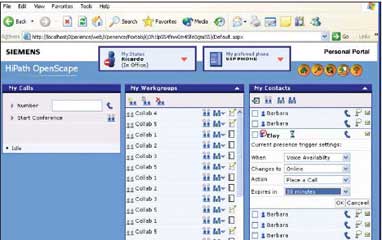The coming war for real-time collaboration solutions


That's Siemens OpenScape, one of several powerful suites that provide for real-time collaboration in the enterprise.
Other utilities in that vogue include Nortel's Multimedia Communications Server and Avaya's Converged Communications Server.
Network World's Johna Till Johnson makes a good point about real-time collaboration going mainstream, and telecom vendors and carriers gearing up for it.
Recent research demonstrates that enterprises are getting read to take the plunge," she writes. "Job titles such as 'SVP of Collaborative Services' are starting to crop up, and the average per-seat price that companies are willing to pay for 'real-time communications dashboards' has leapt from less than $300 to more than $400.
But I see the opportunity for vendor alliances, costly battles, or both.
What's going to be real interesting is the bulking up of traditional IM tools to provide some of these same services as the costly branded offerings of Nortel, Siemens and Avaya. Some of this may be done by vendor alliances between the IMs and the companies I've just named. But there's no reason that traditional IMs cannot build their own real-time collaboration offerings.
Melanie Turek of Nemertes Research views these dashboards as compatible with voice-capable IM, but a signficant expansion of corporate IM tool capabilities:
Real-time communications dashboards improve on basic soft phones with robust find me/follow me capabilities and better integrated voice and data communications (so that, for example, caller who’s available by IM might get a text message, rather than a voice mail, from the person he’s trying to reach). Typically, these dashboards are PC-based, and are designed to work with both IP and analog or digital phones.
Melanie then offers a view about how this would work:
Picture a window that displays all your corporate contacts and indicates whether they’re available by phone, IM or e-mail. Most offer click-to-talk capabilities, so users can make a phone call right from their PC, as well as detailed management capabilities at both the end-user and administrator levels, so people can get very specific about who can reach them, as well as how and when. For instance, a user may opt to have the system send his manager directly to his cell phone after hours, but send all other callers to voicemail. Some have built-in audio conferencing, multi-party chat, and even Web conferencing capabilities.